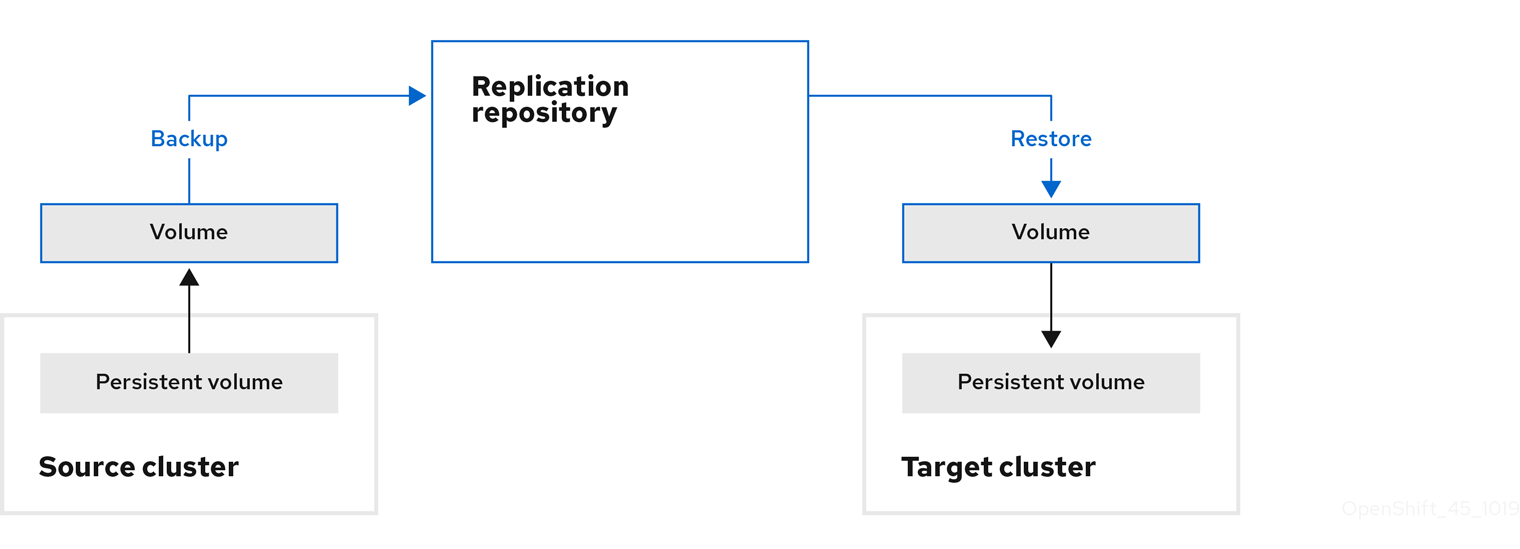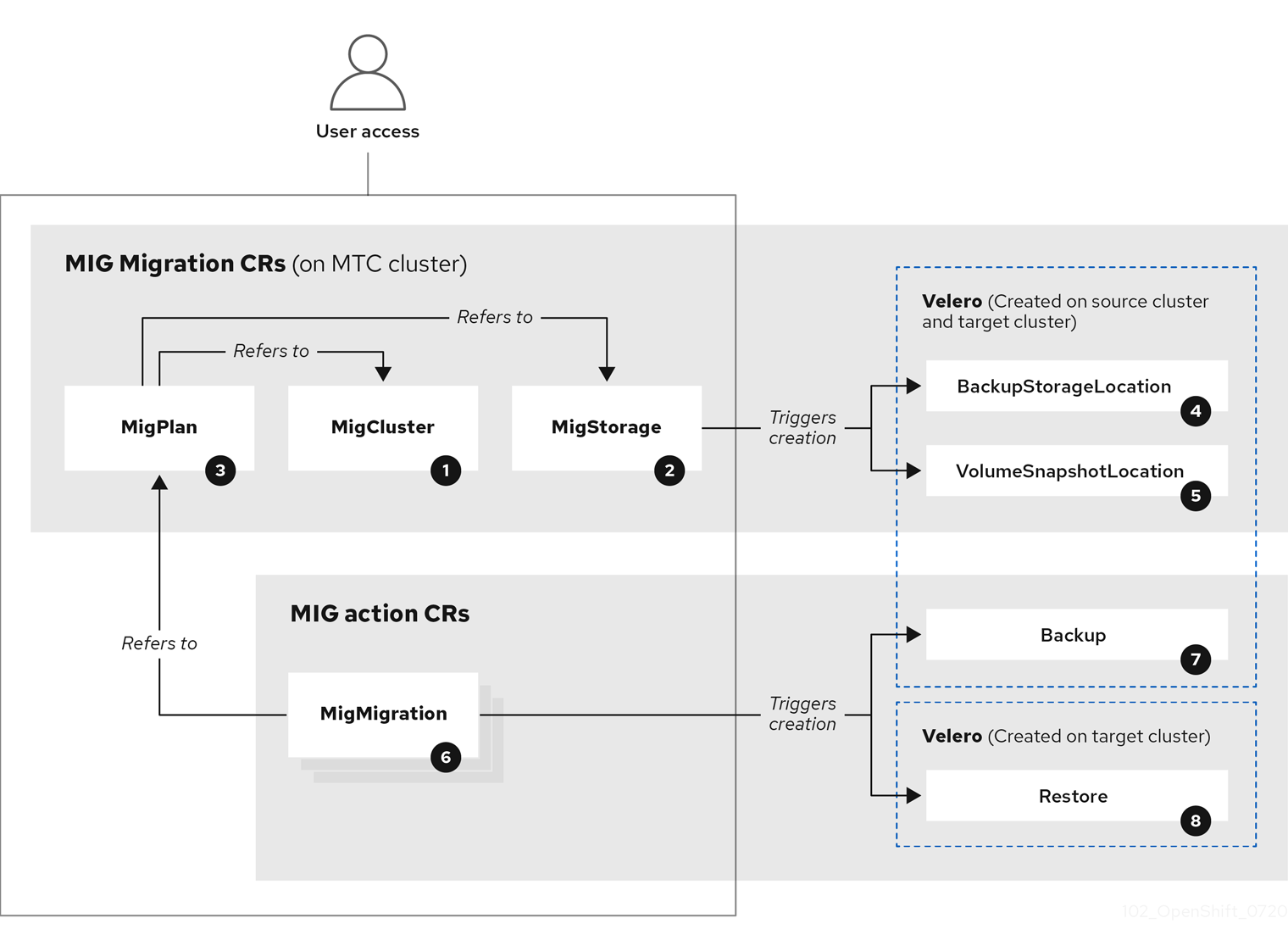1.3. Migration tools and prerequisites
You can migrate application workloads from OpenShift Container Platform 3.7, 3.9, 3.10, and 3.11 to OpenShift Container Platform 4.5 with the Migration Toolkit for Containers (MTC). MTC enables you to control the migration and to minimize application downtime.
The MTC web console and API, based on Kubernetes custom resources, enable you to migrate stateful application workloads at the granularity of a namespace.
MTC supports the file system and snapshot data copy methods for migrating data from the source cluster to the target cluster. You can select a method that is suited for your environment and is supported by your storage provider.
You can use migration hooks to run Ansible playbooks at certain points during the migration. The hooks are added when you create a migration plan.
The service catalog is deprecated in OpenShift Container Platform 4. You can migrate workload resources provisioned with the service catalog from OpenShift Container Platform 3 to 4 but you cannot perform service catalog actions such as provision, deprovision, or update on these workloads after migration.
The MTC web console displays a message if the service catalog resources cannot be migrated.
Before you begin your migration, be sure to review the information on planning your migration.
1.3.1. Migration Toolkit for Containers workflow
You use the Migration Toolkit for Containers (MTC) to migrate Kubernetes resources, persistent volume data, and internal container images from an OpenShift Container Platform source cluster to an OpenShift Container Platform 4.5 target cluster by using the MTC web console or the Kubernetes API.
The (MTC) migrates the following resources:
- A namespace specified in a migration plan.
Namespace-scoped resources: When the MTC migrates a namespace, it migrates all the objects and resources associated with that namespace, such as services or pods. Additionally, if a resource that exists in the namespace but not at the cluster level depends on a resource that exists at the cluster level, the MTC migrates both resources.
For example, a security context constraint (SCC) is a resource that exists at the cluster level and a service account (SA) is a resource that exists at the namespace level. If an SA exists in a namespace that the MTC migrates, the MTC automatically locates any SCCs that are linked to the SA and also migrates those SCCs. Similarly, the MTC migrates persistent volume claims that are linked to the persistent volumes of the namespace.
- Custom resources (CRs) and custom resource definitions (CRDs): The MTC automatically migrates any CRs that exist at the namespace level as well as the CRDs that are linked to those CRs.
Migrating an application with the MTC web console involves the following steps:
Install the Migration Toolkit for Containers Operator on all clusters.
You can install the Migration Toolkit for Containers Operator in a restricted environment with limited or no internet access. The source and target clusters must have network access to each other and to a mirror registry.
Configure the replication repository, an intermediate object storage that MTC uses to migrate data.
The source and target clusters must have network access to the replication repository during migration. In a restricted environment, you can use an internally hosted S3 storage repository. If you are using a proxy server, you must configure it to allow network traffic between the replication repository and the clusters.
- Add the source cluster to the MTC web console.
- Add the replication repository to the MTC web console.
Create a migration plan, with one of the following data migration options:
Copy: MTC copies the data from the source cluster to the replication repository, and from the replication repository to the target cluster.
注意If you are using direct image migration or direct volume migration, the images or volumes are copied directly from the source cluster to the target cluster.

Move: MTC unmounts a remote volume, for example, NFS, from the source cluster, creates a PV resource on the target cluster pointing to the remote volume, and then mounts the remote volume on the target cluster. Applications running on the target cluster use the same remote volume that the source cluster was using. The remote volume must be accessible to the source and target clusters.
注意Although the replication repository does not appear in this diagram, it is required for migration.

Run the migration plan, with one of the following options:
Stage (optional) copies data to the target cluster without stopping the application.
Staging can be run multiple times so that most of the data is copied to the target before migration. This minimizes the duration of the migration and application downtime.
- Migrate stops the application on the source cluster and recreates its resources on the target cluster. Optionally, you can migrate the workload without stopping the application.

1.3.2. Migration Toolkit for Containers custom resources
The Migration Toolkit for Containers (MTC) creates the following custom resources (CRs):

![]() MigCluster (configuration, MTC cluster): Cluster definition
MigCluster (configuration, MTC cluster): Cluster definition
![]() MigStorage (configuration, MTC cluster): Storage definition
MigStorage (configuration, MTC cluster): Storage definition
![]() MigPlan (configuration, MTC cluster): Migration plan
MigPlan (configuration, MTC cluster): Migration plan
The MigPlan CR describes the source and target clusters, replication repository, and namespaces being migrated. It is associated with 0, 1, or many MigMigration CRs.
Deleting a MigPlan CR deletes the associated MigMigration CRs.
![]() BackupStorageLocation (configuration, MTC cluster): Location of
BackupStorageLocation (configuration, MTC cluster): Location of Velero backup objects
![]() VolumeSnapshotLocation (configuration, MTC cluster): Location of
VolumeSnapshotLocation (configuration, MTC cluster): Location of Velero volume snapshots
![]() MigMigration (action, MTC cluster): Migration, created every time you stage or migrate data. Each
MigMigration (action, MTC cluster): Migration, created every time you stage or migrate data. Each MigMigration CR is associated with a MigPlan CR.
![]() Backup (action, source cluster): When you run a migration plan, the
Backup (action, source cluster): When you run a migration plan, the MigMigration CR creates two Velero backup CRs on each source cluster:
- Backup CR #1 for Kubernetes objects
- Backup CR #2 for PV data
![]() Restore (action, target cluster): When you run a migration plan, the
Restore (action, target cluster): When you run a migration plan, the MigMigration CR creates two Velero restore CRs on the target cluster:
- Restore CR #1 (using Backup CR #2) for PV data
- Restore CR #2 (using Backup CR #1) for Kubernetes objects
1.3.3. About data copy methods
The Migration Toolkit for Containers (MTC) supports the file system and snapshot data copy methods for migrating data from the source cluster to the target cluster. You can select a method that is suited for your environment and is supported by your storage provider.
1.3.3.1. File system copy method
MTC copies data files from the source cluster to the replication repository, and from there to the target cluster.
表 1.1. File system copy method summary
| Benefits | Limitations |
|---|---|
|
|
1.3.3.2. Snapshot copy method
MTC copies a snapshot of the source cluster data to the replication repository of a cloud provider. The data is restored on the target cluster.
AWS, Google Cloud Provider, and Microsoft Azure support the snapshot copy method.
表 1.2. Snapshot copy method summary
| Benefits | Limitations |
|---|---|
|
|
1.3.4. About migration hooks
You can use migration hooks to run custom code at certain points during a migration with the Migration Toolkit for Containers (MTC). You can add up to four migration hooks to a single migration plan, with each hook running at a different phase of the migration.
Migration hooks perform tasks such as customizing application quiescence, manually migrating unsupported data types, and updating applications after migration.
A migration hook runs on a source or a target cluster at one of the following migration steps:
-
PreBackup: Before resources are backed up on the source cluster -
PostBackup: After resources are backed up on the source cluster -
PreRestore: Before resources are restored on the target cluster -
PostRestore: After resources are restored on the target cluster
You can create a hook by using an Ansible playbook or a custom hook container.
Ansible playbook
The Ansible playbook is mounted on a hook container as a config map. The hook container runs as a job, using the cluster, service account, and namespace specified in the MigPlan custom resource (CR). The job continues to run until it reaches the the default limit of 6 retries or a successful completion. This continues even if the initial pod is evicted or killed.
The default Ansible runtime image is registry.redhat.io/rhmtc/openshift-migration-hook-runner-rhel7:1.4. This image is based on the Ansible Runner image and includes python-openshift for Ansible Kubernetes resources and an updated oc binary.
Optional: You can use a custom Ansible runtime image containing additional Ansible modules or tools instead of the default image.
Custom hook container
You can create a custom hook container that includes Ansible playbooks or custom code.

